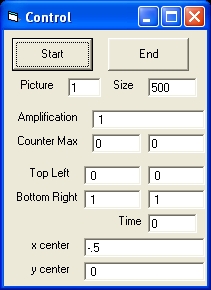Using the mouse you can select different parts of this Universe, enlarge the dipslay and new galaxies will appear ad infinitum.
The program "VB2010 FGalaxy PP" is identical as the program "VB2010 FGalaxy". The only difference is that the first uses Parallel Programming and the second not.
For all basic information select Program: VB2010 FGalaxy
This same functionality is also implemented using Visual Basic 5.0. To get more information go to: Visual Basic 5.0 Fractal Galaxy Program: "VB FGalaxy.bas"
For an explanation of the Mandelbrot Set See: Mandelbrot Set
To travel through this Fractal Universe select the following picture.

|
